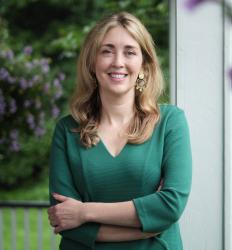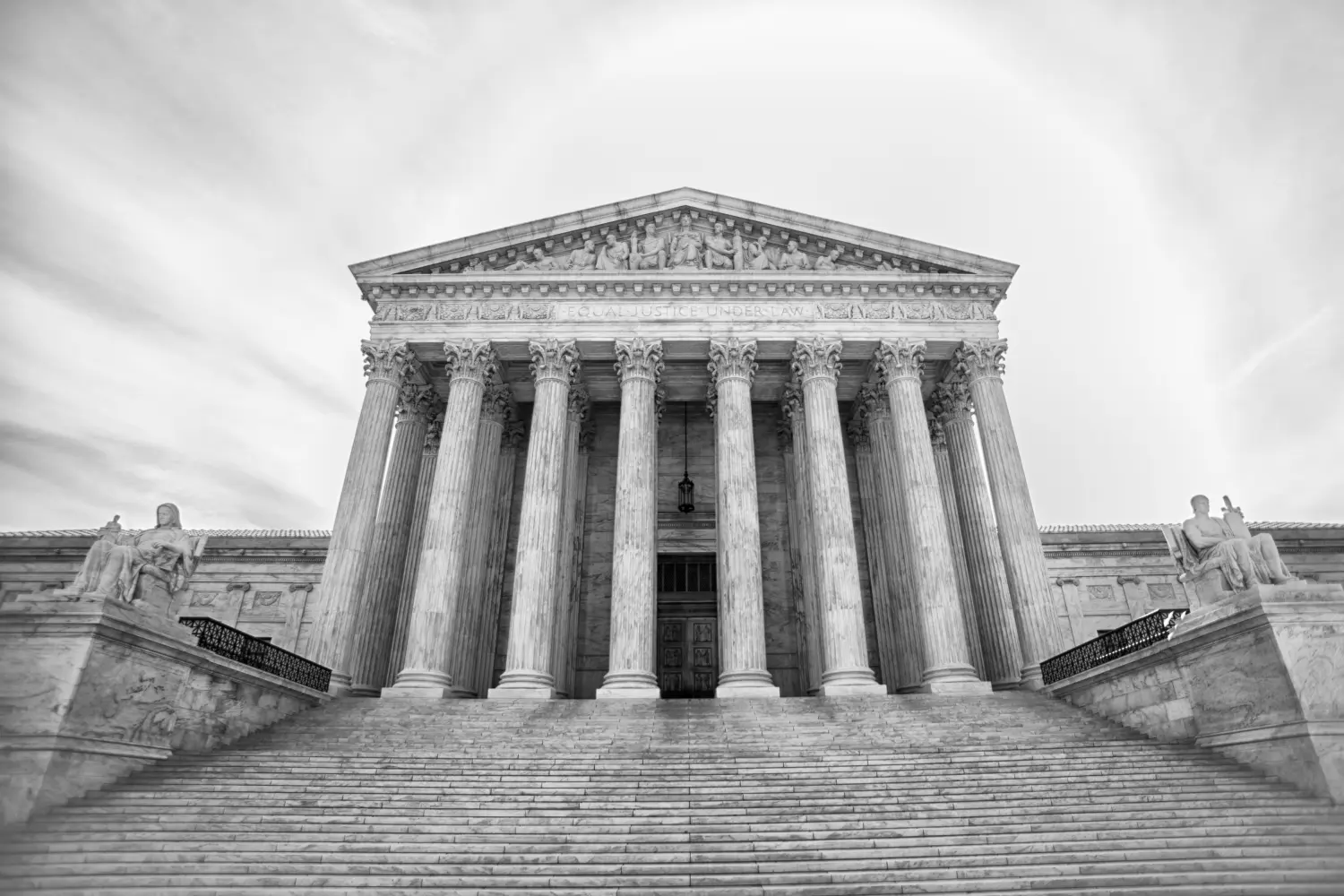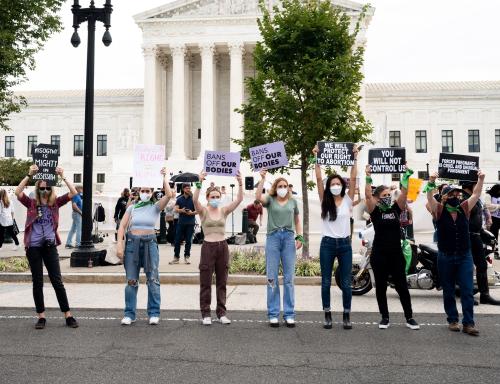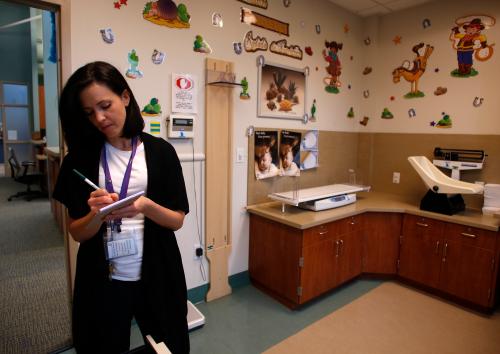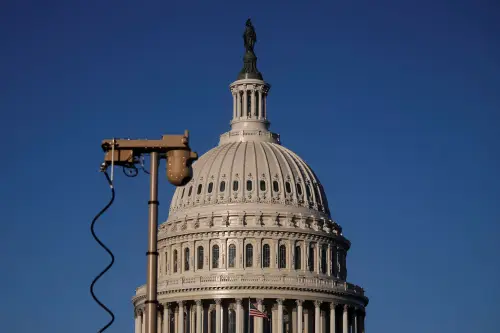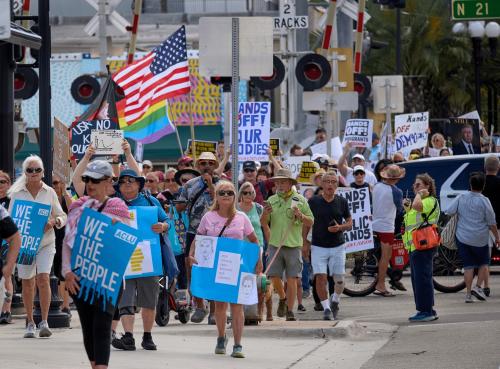On September 20, 2021, a group of 154 distinguished economists and researchers filed an amicus brief to the Supreme Court of the United States in advance of the Mississippi case, Dobbs v. Jackson Women’s Health Organization. For a full review of the evidence that shows how causal inference tools have been used to measure the effects of abortion access in the U.S., read the brief here.
Introduction
Dobbs v. Jackson Women’s Health Organization considers the constitutionality of a 2018 Mississippi law that prohibits women from accessing abortions after 15 weeks of pregnancy. This case is widely expected to determine the fate of Roe v. Wade as Mississippi is directly challenging the precedent set by the Supreme Court’s decisions in Roe, which protects abortion access before fetal viability (typically between 24 and 28 weeks of pregnancy). On December 1, 2021, the Supreme Court will hear oral arguments in Dobbs v. Jackson. In asking the Court to overturn Roe, the state of Mississippi offers reassurances that “there is simply no causal link between the availability of abortion and the capacity of women to act in society”1 and hence no reason to believe that abortion access has shaped “the ability of women to participate equally in the economic and social life of the Nation”2 as the Court had previously held.
While the debate over abortion often centers on largely intractable subjective questions of ethics and morality, in this instance the Court is being asked to consider an objective question about the causal effects of abortion access on the lives of women and their families. The field of economics affords insights into these objective questions through the application of sophisticated methodological approaches that can be used to isolate and measure the causal effects of abortion access on reproductive, social, and economic outcomes for women and their families.
Separating Correlation from Causation: The “Credibility Revolution” in Economics
To measure the causal effect of abortion on women’s lives, one must differentiate its effects from those of other forces, such as economic opportunity, social mores, the availability of contraception. Powerful statistical methodologies in the causal inference toolbox have made it possible for economists to do just that, moving beyond the maxim “correlation isn’t necessarily causation” and applying the scientific method to figure out when it is.
This year’s decision by the Economic Sciences Prize Committee recognized the contributions3 of economists David Card, Joshua Angrist, and Guido Imbens, awarding them the Nobel Prize for their pathbreaking work developing and applying the tools of causal inference in a movement dubbed “the credibility revolution” (Angrist and Pischke, 2010). The gold standard for establishing such credibility is a well-executed randomized controlled trial – an experiment conducted in the lab or field in which treatment is randomly assigned. When economists can feasibly and ethically implement such experiments, they do. However, in the social world, this opportunity is often not available. For instance, one cannot feasibly or ethically randomly assign abortion access to some individuals but not others. Faced with this obstacle, economists turn to “natural” or “quasi” experimental methods, ones in which they are able to credibly argue that treatment is as good as randomly assigned.
Pioneering applications of this approach include work by Angrist and Krueger (1991) leveraging variation in compulsory school attendance laws to measure the effects of schooling on earnings and work by Card and Krueger (1994) leveraging minimum wage variation across state borders to measure the effects of the minimum wages on employment outcomes. The use of these methods is now widespread, not just in economics, but in other social sciences as well. Fueled by advances in computing technology and the availability of data, quasi-experimental methodologies have become as ubiquitous as they are powerful, applied to answer questions ranging from the effects of economic shocks on civil conflict (Miguel, Sayanath, and Sergenti, 2004), to the effects of the Clean Water Act on water pollution levels (Keiser and Shapiro, 2019), and effects of access to food stamps in childhood on later life outcomes (Hoynes, Schanzenbach, Almond 2016; Bailey et al., 2020).
Research demonstrates that abortion access does, in fact, profoundly affect women’s lives by determining whether, when, and under what circumstances they become mothers.
Economists also have applied these tools to study the causal effects of abortion access. Research drawing on methods from the “credibility revolution” disentangles the effects of abortion policy from other societal and economic forces. This research demonstrates that abortion access does, in fact, profoundly affect women’s lives by determining whether, when, and under what circumstances they become mothers, outcomes which then reverberate through their lives, affecting marriage patterns, educational attainment, labor force participation, and earnings.
The Effects of Abortion Access on Women’s Reproductive, Economic, and Social Lives
Evidence of the effects of abortion legalization
The history of abortion legalization in the United States affords both a canonical and salient example of a natural experiment. While Roe v. Wade legalized abortion in most of the country in 1973, five states—Alaska, California, Hawaii, New York, and Washington—and the District of Columbia repealed their abortion bans several years in advance of Roe. Using a methodology known as “difference-in-difference estimation,” researchers compared changes in outcomes in these “repeal states” when they lifted abortion bans to changes in outcomes in the rest of the country. They also compared changes in outcomes in the rest of the country in 1973 when Roe legalized abortion to changes in outcomes in the repeal states where abortion already was legal. This difference-in-differences methodology allows the states where abortion access is not changing to serve as a counterfactual or “control” group that accounts for other forces that were impacting fertility and women’s lives in the Roe era.
Among the first to employ this approach was a team of economists (Levine, Staiger, Kane, and Zimmerman, 1999) who estimated that the legalization of abortion in repeal states led to a 4% to 11% decline in births in those states relative to the rest of the country. Levine and his co-authors found that these fertility effects were particularly large for teens and women of color, who experienced birth rate reductions that were nearly three times greater than the overall population as a result of abortion legalization. Multiple research teams have replicated the essential finding that abortion legalization substantially impacted American fertility while extending the analysis to consider other outcomes.4 For example, Myers (2017) found that abortion legalization reduced the number of women who became teen mothers by 34% and the number who became teen brides by 20%, and again observed effects that were even larger for Black teens. Farin, Hoehn-Velasco, and Pesko (2021) found that abortion legalization reduced maternal mortality among Black women by 30-40%, with little impact on white women, offering the explanation that where abortion was illegal, Black women were less likely to be able to access safe abortions by traveling to other states or countries or by obtaining a clandestine abortion from a trusted health care provider.
The ripple effects of abortion access on the lives of women and their families
This research, which clearly demonstrates the causal relationship between abortion access and first-order demographic and health outcomes, laid the foundation for researchers to measure further ripple effects through the lives of women and their families. Multiple teams of authors have extended the difference-in-differences research designs to study educational and labor market outcomes, finding that abortion legalization increased women’s education, labor force participation, occupational prestige, and earnings and that all these effects were particularly large for Black women (Angrist and Evans, 1996; Kalist, 2004; Lindo, Pineda-Torres, Pritchard, and Tajali, 2020; Jones, 2021).
Additionally, research shows that abortion access has not only had profound effects on women’s economic and social lives but has also impacted the circumstances into which children are born. Researchers using difference-in-differences research designs have found that abortion legalization reduced the number of children who were unwanted (Bitler and Zavodny, 2002a, reduced cases of child neglect and abuse (Bitler and Zavodny, 2002b; 2004), reduced the number of children who lived in poverty (Gruber, Levine, and Staiger, 1999), and improved long-run outcomes of an entire generation of children by increasing the likelihood of attending college and reducing the likelihood of living in poverty and receiving public assistance (Ananat, Gruber, Levine, and Staiger, 2009).
Access to abortion continues to be important to women’s lives
The research cited above relies on variation in abortion access from the 1970s, and much has changed in terms of both reproductive technologies and women’s lives. Recent research shows, however, that even with the social, economic, and legal shifts that have occurred over the last few decades and even with expanded access to contraception, abortion access remains relevant to women’s reproductive lives. Today, nearly half of pregnancies are unintended (Finer and Zolna, 2016). About 6% of young women (ages 15-34) experience an unintended pregnancy each year (Finer, Lindberg, and Desai, 2018), and about 1.4% of women of childbearing age obtain an abortion each year (Jones, Witwer, and Jerman, 2019). At these rates, approximately one in four women will receive an abortion in their reproductive lifetimes. The fact is clear: women continue to rely on abortion access to determine their reproductive lives.
But what about their economic and social lives? While women have made great progress in terms of their educational attainment, career trajectories, and role in society, mothers face a variety of challenges and penalties that are not adequately addressed by public policy. Following the birth of a child, it’s well documented that working mothers face a “motherhood wage penalty,” which entails lower wages than women who did not have a child (Waldfogel, 1998; Anderson, Binder, and Krause, 2002; Kelven et al., 2019). Maternity leave may combat this penalty as it allows women to return to their jobs following the birth of a child – encouraging them to remain attached to the labor force (Rossin-Slater, 2017). However, as of this writing, the U.S. only offers up to 12 weeks of unpaid leave through the FMLA, which extends coverage to less than 60% of all workers.5 And even if a mother is able to return to work, childcare in the U.S. is costly and often inaccessible for many. Families with infants can be expected to pay around $11,000 a year for childcare and subsidies are only available for 1 in 6 children that are eligible under the federal program.6 Without a federal paid leave policy and access to affordable childcare, the U.S. lacks the infrastructure to adequately support mothers, and especially working mothers – making the prospect of motherhood financially unworkable for some.
This is relevant when considering that the women who seek abortions tend to be low-income mothers experiencing disruptive life events. In the most recent survey of abortion patients conducted by the Guttmacher Institute, 97% are adults, 49% are living below the poverty line, 59% already have children, and 55% are experiencing a disruptive life event such as losing a job, breaking up with a partner, or falling behind on rent (Jones and Jerman, 2017a and 2017b). It is not a stretch to imagine that access to abortion could be pivotal to these women’s financial lives, and recent evidence from “The Turnaway Study”7 provides empirical support for this supposition. In this study, an interdisciplinary team of researchers follows two groups of women who were typically seeking abortions in the second trimester: one group that arrived at abortion clinics and learned they were just over the gestational age threshold for abortions and were “turned away” and a second that was just under the threshold and were provided an abortion. Miller, Wherry, and Foster (2020) match individuals in both groups to their Experian credit reports and observe that in the months leading up to the moment they sought an abortion, financial outcomes for both groups were trending similarly. At the moment one group is turned away from a wanted abortion, however, they began to experience substantial financial distress, exhibiting a 78% increase in past-due debt and an 81% increase in public records related to bankruptcies, evictions, and court judgments.
If Roe were overturned, the number of women experiencing substantial obstacles to obtaining an abortion would dramatically increase.
If Roe were overturned, the number of women experiencing substantial obstacles to obtaining an abortion would dramatically increase. Twelve states have enacted “trigger bans” designed to outlaw abortion in the immediate aftermath of a Roe reversal, while an additional 10 are considered highly likely to quickly enact new bans.8 These bans would shutter abortion facilities across a wide swath of the American south and midwest, dramatically increasing travel distances and the logistical costs of obtaining an abortion. Economics research predicts what is likely to happen next. Multiple teams of economists have exploited natural experiments arising from mandatory waiting periods (Joyce and Kaestner, 2001; Lindo and Pineda-Torres, 2021; Myers, 2021) and provider closures (Quast, Gonzalez, and Ziemba, 2017; Fischer, Royer, and White, 2018; Lindo, Myers, Schlosser, and Cunningham, 2020; Venator and Fletcher, 2021; Myers, 2021). All have found that increases in travel distances prevent large numbers of women seeking abortions from reaching a provider and that most of these women give birth as a result. For instance, Lindo and co-authors (2020) exploit a natural experiment arising from the sudden closure of half of Texas’s abortion clinics in 2013 and find that an increase in travel distance from 0 to 100 miles results in a 25.8% decrease in abortions. Myers, Jones, and Upadhyay (2019) use these results to envision a post-Roe United States, forecasting that if Roe is overturned and the expected states begin to ban abortions, approximately 1/3 of women living in affected regions would be unable to reach an abortion provider, amounting to roughly 100,000 women in the first year alone.
Restricting, or outright eliminating, abortion access by overturning Roe v. Wade would diminish women’s personal and economic lives, as well as the lives of their families.
Conclusion
Whether one’s stance on abortion access is driven by deeply held views on women’s bodily autonomy or when life begins, the decades of research using rigorous methods is clear: there is a causal link between access to abortion and whether, when, and under what circumstances women become mothers, with ripple effects throughout their lives. Access affects their education, earnings, careers, and the subsequent life outcomes for their children. In the state’s argument, Mississippi rejects the causal link between access to abortion and societal outcomes established by economists and states that the availability of abortion isn’t relevant to women’s full participation in society. Economists provide clear evidence that overturning Roe would prevent large numbers of women experiencing unintended pregnancies—many of whom are low-income and financially vulnerable mothers—from obtaining desired abortions. Restricting, or outright eliminating, that access by overturning Roe v. Wade would diminish women’s personal and economic lives, as well as the lives of their families.
Caitlin Knowles Myers did not receive financial support from any firm or person for this article. She has received financial compensation from Planned Parenthood Federation of America and the Center for Reproductive Rights for serving as an expert witness in litigation involving abortion regulations. She has not and will not receive financial compensation for her role in the amicus brief described here. Other than the aforementioned, she has not received financial support from any firm or person with a financial or political interest in this article. Caitlin Knowles Myers is not currently an officer, director, or board member of any organization with a financial or political interest in this article.
Sources
Abboud, Ali, 2019. “The Impact of Early Fertility Shocks on Women’s Fertility and Labor Market Outcomes.” Available from SSRN: https://ssrn.com/abstract=3512913
Anderson, Deborah J., Binder, Melissa, and Kate Krause, 2002. “The motherhood wage penalty: Which mothers pay it and why?” The American Economic Review 92(2). Retrieved from https://www.aeaweb.org/articles?id=10.1257/000282802320191606
Ananat, Elizabeth Oltmans, Gruber, Jonathan, Levine, Phillip and Douglas Staiger, 2009. “Abortion and Selection.” The Review of Economic Statistics 91(1). Retrieved from https://direct.mit.edu/rest/article-abstract/91/1/124/57736/Abortion-and-Selection?redirectedFrom=fulltext.
Angrist, Joshua D., and Alan B. Krueger, 1999. “Does Compulsory School Attendance Affect Schooling and Earnings?” The Quarterly Journal of Economics 106(4). Retrieved from https://doi.org/10.2307/2937954.
Angrist, Joshua D., and William N. Evans, 1996. “Schooling and Labor Market Consequences of the 1970 State Abortion Reforms.” National Bureau of Economic Research Working Paper 5406. Retrieved from https://www.nber.org/papers/w5406.
Angrist, Joshua D., and Jörn-Steffen Pischke, 2010. “The Credibility Revolution in Empirical Economics: How Better Research Design Is Taking the Con out of Econometrics.” Journal of Economic Perspectives 24(2). Retrieved from https://www.aeaweb.org/articles?id=10.1257/jep.24.2.3
Bailey, Martha J., Hoynes, Hilary W., Rossin-Slater, Maya and Reed Walker, 2020. “Is the Social Safety Net a Long-Term Investment? Large-Scale Evidence from the Food Stamps Program” National Bureau of Economic Research Working Paper 26942, Retrieved from https://www.nber.org/papers/w26942
Bitler, Marianne, and Madeline Zavodny, 2002a. “Did Abortion Legalization Reduce the Number of Unwanted Children? Evidence from Adoptions.” Perspectives on Sexual and Reproductive Health, 34 (1): 25-33. Retrieved from https://www.jstor.org/stable/3030229?origin=JSTOR-pdf
Bitler, Marianne, and Madeline Zavodny, 2002b. “Child Abuse and Abortion Availability.” American Economic Review, 92 (2): 363-367. Retrieved from https://www.aeaweb.org/articles?id=10.1257/000282802320191624
Bitler, Marianne, and Madeline Zavodny, 2004. “Child Maltreatment, Abortion Availability, and Economic Conditions.” Review of Economics of the Household 2: 119-141. Retrieved from https://doi.org/10.1023/B:REHO.0000031610.36468.0e
Farin, Sherajum Monira, Hoehn-Velasco, Lauren, and Michael Pesko, 2021. “The Impact of Legal Abortion on Maternal Health: Looking to the Past to Inform the Present.” Retrieved from SSRN: https://papers.ssrn.com/sol3/papers.cfm?abstract_id=3913899
Finer, Lawrence B., and Mia R. Zolna, 2016. “Declines in Unintended Pregnancy in the United States, 2008–2011” New England Journal of Medicine 374. Retrieved from https://pubmed.ncbi.nlm.nih.gov/26962904/
Finer, Lawrence B., Lindberg, Laura, D., and Sheila Desai. “A prospective measure of unintended pregnancy in the United States.” Contraception 98(6). Retrieved from https://pubmed.ncbi.nlm.nih.gov/29879398/
Fischer, Stefanie, Royer, Heather, and Corey White, 2017. “The Impacts of Reduced Access to Abortion and Family Planning Services on Abortion, Births, and Contraceptive Purchases.” National Bureau of Economic Research Working Paper 23634. Retrieved from https://www.nber.org/papers/w23634
Gruber, Jonathan, Levine, Phillip, and Douglas Staiger, 1999. “Abortion Legalization and Child Living Circumstances: Who Is the ‘Marginal Child’?” Quarterly Journal of Economics 114. Retrieved from https://doi.org/10.1162/003355399556007
Guldi, Melanie, 2008. “Fertility effects of abortion and birth control pill access for minors.” Demography 45. Retrieved from https://doi.org/10.1353/dem.0.0026
Hoynes, Hilary, Schanzenbach, Diane Whitmore, and Douglas Almond, 2016. “Long-Run Impacts of Childhood Access to the Safety Net.” American Economic Review 106(4). Retrieved from https://www.aeaweb.org/articles?id=10.1257/aer.20130375
Jones, Kelly, 2021. “At a Crossroads: The Impact of Abortion Access on Future Economic Outcomes.” American University Working Paper. Retrieved from https://doi.org/10.17606/0Q51-0R11.
Jones, Rachel K., Witwer, Elizabeth, Jerman, Jenna, September 18, 2018. “Abortion Incidence and Service Availability in the United States, 2017.” Guttmacher Institute. Retrieved from https://www.guttmacher.org/sites/ default/files/report_pdf/abortion-inciden ce-service-availability-us-2017.
Jones Rachel K., and Janna Jerman, 2017a. ”Population group abortion rates and lifetime incidence of abortion: United States, 2008–2014.” American Journal of Public Health 107 (12). Retrieved from https://ajph.aphapublications.org/doi/full/10.2105/AJPH.2017.304042
Jones, Rachel K. and Jenna Jerman, 2017b. “Characteristics and Circumstances of U.S. Women Who Obtain Very Early and Second-Trimester Abortions.” PLoS One. Retrieved from https://pubmed.ncbi.nlm.nih.gov/28121999/
Joyce, Ted, and Robert Kaestner, 2001. “The Impact of Mandatory Waiting Periods and Parental Consent Laws on the Timing of Abortion and State of Occurrence among Adolescents in Mississippi and South Carolina.” Journal of Policy Analysis and Management 20(2). Retrieved from https://www.jstor.org/stable/3325799.
Kalist, David E., 2004. “Abortion and Female Labor Force Participation: Evidence Prior to Roe v. Wade.” Journal of Labor Research 25 (3).
Keiser, David, and Joseph Shapiro, 2019. “Consequences of the Clean Water Act and the Demand for Water Quality.” The Quarterly Journal of Economics 134 (1).
Kleven, Henrik, Landais, Camille, Posch, Johanna, Steinhauer, Andreas, and Josef Zweimuleler, 2019. “Child Penalties Across Countries: Evidence and Explanations.” AEA Papers and Proceedings 109. Retrieved from https://www.aeaweb.org/articles?id=10.1257/pandp.20191078/
Levine, Phillip, Staiger, Douglas, Kane, Thomas, and David Zimmerman, 1999. “Roe v. Wade and American Fertility.” American Journal Of Public Health 89(2). Retrieved from https://www.ncbi.nlm.nih.gov/pmc/articles/PMC1508542/
Lindo, Jason M., Myers, Caitlin Knowles, Schlosser, Andrea, and Scott Cunningham, 2020. “How Far Is Too Far? New Evidence on Abortion Clinic Closures, Access, and Abortions” Journal of Human Resources 55. Retrieved from http://jhr.uwpress.org/content/55/4/1137.refs
Lindo, Jason M., Pineda-Torres, Mayra, Pritchard, David, and Hedieh Tajali, 2020. “Legal Access to Reproductive Control Technology, Women’s Education, and Earnings Approaching Retirement.” AEA Papers and Proceedings 110. Retrieved from https://www.aeaweb.org/articles?id=10.1257/pandp.20201108
Lindo, Jason M., and Mayra Pineda-Torres, 2021. “New Evidence on the Effects of Mandatory Waiting Periods for Abortion.” Journal of Health Economics. Retrieved from https://pubmed.ncbi.nlm.nih.gov/34607119/
Miguel, Edward, Satyanath, Shanker, and Ernest Sergenti, 2004. “Economic Shocks and Civil Conflict: An Instrumental Variables Approach.” Journal of Political Economy 112(4). Retrieved from https://www.jstor.org/stable/10.1086/421174
Miller, Sarah, Wherry, Laura R., and Diana Greene Foster, 2020. “The Economic Consequences of Being Denied an Abortion.” National Bureau of Economic Research, Working Paper 26662. Retrieved from https://www.nber.org/papers/w26662.
Myers, Caitlin Knowles, 2017. “The Power of Abortion Policy: Reexamining the Effects of Young Women’s Access to Reproductive Control” Journal of Political Economy 125(6). Retrieved from https://doi.org/10.1086/694293.
Myers, Caitlin Knowles, Jones, Rachel, and Ushma Upadhyay, 2019. “Predicted changes in abortion access and incidence in a post-Roe world.” Contraception 100(5). Retrieved from https://pubmed.ncbi.nlm.nih.gov/31376381/
Myers, Caitlin Knowles, 2021. “Cooling off or Burdened? The Effects of Mandatory Waiting Periods on Abortions and Births.” IZA Institute of Labor Economics No. 14434. Retrieved from https://www.iza.org/publications/dp/14434/cooling-off-or-burdened-the-effects-of-mandatory-waiting-periods-on-abortions-and-births
Quast, Troy, Gonzalez, Fidel, and Robert Ziemba, 2017. “Abortion Facility Closings and Abortion Rates in Texas.” Inquiry: A Journal of Medical Care Organization, Provision and Financing 54. Retrieved from https://journals.sagepub.com/doi/full/10.1177/0046958017700944
Rossin-Slater, Maya, 2017. “Maternity and Family Leave Policy.” National Bureau of Economic Research Working Paper 23069. Retrieved from https://www.nber.org/papers/w23069
Venator, Joanna, and Jason Fletcher, 2020. “Undue Burden Beyond Texas: An Analysis of Abortion Clinic Closures, Births, and Abortions in Wisconsin.” Journal of Policy Analysis and Management 40(3). Retrieved from https://doi.org/10.1002/pam.22263
Waldfogel, Jane, 1998. “The family gap for young women in the United States and Britain: Can maternity leave make a difference?” Journal of Labor Economics 16(3).
-
Footnotes
- Thomas E. Dobbs v. Jackson Women’s Health Organization. On Writ of Certiorari to the United States Court of Appeals for the Fifth Circuit, Brief in Support of Petitioners, No. 19-1392.
- Thomas E. Dobbs v. Jackson Women’s Health Organization. On Writ of Certiorari to the United States Court of Appeals for the Fifth Circuit, Brief for Petitioners, No. 19-139, Retrieved from https://www.supremecourt.gov/DocketPDF/19/19-1392/184703/20210722161332385_19-1392BriefForPetitioners.pdf
- The Nobel Prize. 2021. “Press release: The Prize in Economic Sciences 202.” Retrieved from https://www.nobelprize.org/prizes/economic-sciences/2021/press-release/
- See Angrist and Evans (1996), Gruber et al. (1999), Ananat et al. (2009), Guldi (2008), Myers (2017), Abboud (2019), Jones (2021).
-
Brown, Scott, Herr, Jane, Roy, Radha , and Jacob Alex Klerman, July 2020. “Employee and Worksite Perspectives of the FMLA
Who Is Eligible?” U.S. Department of Labor. Retrieved from https://www.dol.gov/sites/dolgov/files/OASP/evaluation/pdf/WHD_FMLA2018PB1WhoIsEligible_StudyBrief_Aug2020.pdf - Whitehurst, Grover J., April 19, 2018. “What is the market price of daycare and preschool?” Brookings Institution. Retrieved from https://www.brookings.edu/research/what-is-the-market-price-of-daycare-and-preschool/; Chien, Nina, 2021. “Factsheet: Estimates of Child Care Eligibility & Receipt for Fiscal Year 2018.” U.S. Department of Health and Human Services. Retrieved from https://aspe.hhs.gov/sites/default/files/20 21-08/cy-2018-child-care-subsidy-eligibility.pdf
- Advancing New Standards in Reproductive Health (NSIRH). “The Turnaway Study.” Retrieved from https://www.ansirh.org/research/ongoing/turnaway-study.
- Center for Reproductive Rights, 2021. “What If Roe Fell?” Retrieved from https://maps.reproductiverights.org/what-if-roe-fell
Who Is Eligible?” U.S. Department of Labor. Retrieved from https://www.dol.gov/sites/dolgov/files/OASP/evaluation/pdf/WHD_FMLA2018PB1WhoIsEligible_StudyBrief_Aug2020.pdf
The Brookings Institution is committed to quality, independence, and impact.
We are supported by a diverse array of funders. In line with our values and policies, each Brookings publication represents the sole views of its author(s).
